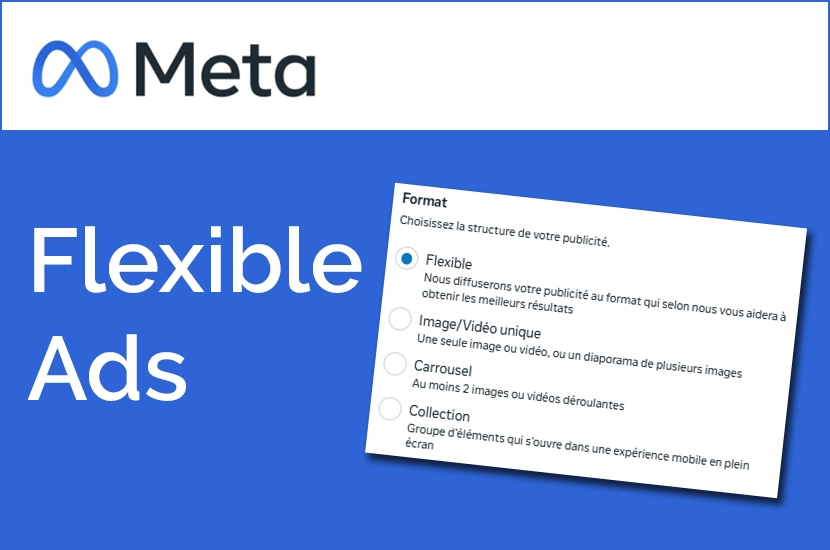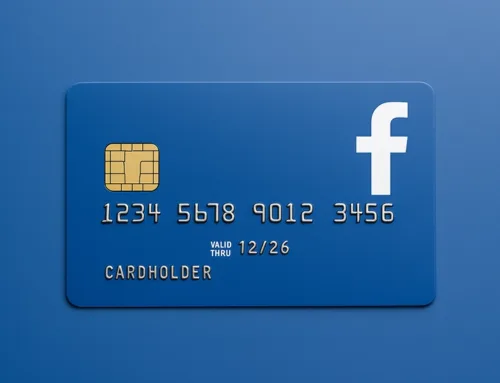In an increasingly competitive digital environment, capturing the attention of Internet users is a real challenge. Rigid advertising formats often struggle to adapt to multiple platforms, screens and user behavior. Meta has responded to this challenge with Flexible Ads, a dynamic advertising format designed to deliver more relevant, personalized and effective ads.
In this article, we’ll explain what Flexible Ads is , how it can benefit your marketing strategy, how it works and how to get the most out of it. We conclude with a case study we conducted with Palais des Thés on this new format.
What is Meta’s Flexible Ads format?
Meta has been offering automation solutions for several years, such asAdvantage+, its conversion campaign automation model. Flexible Ads are a new advertising format designed to automatically adapt to the delivery context and specificities of your audience. This format allows you to submit up to 3 groups of 10 images and videos in different formats (i.e. 30 creative assets) for a single ad. From the assets in a group, Meta will create formats (image, video, carousel) based on placement (Facebook, Instagram, Audience Network, news feed, story, reels, etc.) and the characteristics of the targeted user.
Why use Flexible Ads: benefits for advertisers
Maximum flexibility
A single creative package can be used to create multiple ad formats: image, carousel, video… To do this, you need to integrate all the formats into the same ad, and then Meta will decide which format to use according to location.
Advanced automation
Meta’s AI analyzes user signals and adapts delivery in real time to maximize engagement and conversion. You benefit from continuous optimization without manual effort.
Save time and resources
Even if it’s necessary to create variants, production is less time-consuming than creating multiple variations for each platform! You reduce the time spent on creation and configuration, freeing up resources for your strategy.
Reduced advertising fatigue
Flexible Ads helps avoid audience fatigue by automatically varying the format and content displayed. The result is more receptive users and a better experience.
Optimized performance
By automatically adapting to the placement and profile of the user, Flexible Ads can improve your key indicators: click-through rates, CPC, CPA and return on investment (ROI). Because Meta’s AI not only adapts the size of ads, it also anticipates their performance. By studying user behavior, it chooses to deliver creative in the most effective format.
How does Flexible Ads work?
Meta has designed this format to be both powerful and easy to use. Here are the main steps:
- Campaign creation
Start by creating or selecting a campaign in the Meta Ad Manager. Flexible Ads is available for “Sales” and “Application Promotion” objectives. - Choice of Flexible Ads format
Select the Flexible format at the advertising level. - Download assets
Import up to 10 images or videos in 3 groups. You can vary the content to give the algorithm more choice. - Creative optimization
Combine your assets with a variety of titles and descriptions. Meta will automatically test the most effective combinations thanks to the creative optimization option. - Automated delivery
The delivery system selects the optimal format (single image, carousel, video) for each user and placement, maximizing the campaign’s impact.
Good to know:
A preview is available to check rendering on different placements (Feed, Stories, Reels).
Practical guide to successful campaigns with Flexible Ads
To maximize the potential of Flexible Ads, here are a few best practices recommended by Meta and our social ads experts:
Create high-quality visuals
- Opt for well-crafted images or videos that are consistent with your visual identity and that show off your products and your brand.
- Choose formats suitable for vertical and square positioning.
Varying formats and content
- Use a combination of images and videos to broaden the possibilities for broadcasting.
- Show the diversity of your offer to capture different segments of your audience.
Writing catchy titles and descriptions
- Include a clear call to action (CTA).
- Use the right keywords to increase relevance and improve ad quality.
Exploiting creative optimization
- Test several variations of titles and visuals.
- Let Meta identify the most effective combinations thanks to AI.
Check rendering
Before launching your campaign, use the preview function to ensure that the message is clear on all placements.
Measuring and optimizing performance
With Flexible Ads comes rigorous performance tracking. Here’s how:
Analyzing reports in Ads Manager
- Impressions
- Clicks
- Click-through rate (CTR)
- Conversions
Study specific reports
- Reports by placement to find out where your ads perform best.
Continuous iteration
- Adjust your creations and targeting according to the insights you gather.
Outlook: the future of Meta advertising
Flexible Ads are just another step in Meta’s advertising automation strategy. Meta is investing heavily in AI and generative tools that should soon enable :
- Automatically generate text and visual variations from a basic concept.
- Create even more immersive experiences with AR formats or Reels.
- Offer richer storytelling tailored to user expectations.
Meta’s Flexible Ads format transforms the way advertising campaigns are designed and delivered. By enabling advanced personalization and automation, it frees advertisers from technical constraints while improving performance: more engagement, more conversions and a better return on investment.
To make the most of this innovative format, it’s essential to take care of the quality of your creatives, vary your assets and monitor your performance to continuously refine your strategy.
So why should you integrate Flexible Ads into your strategy?
- To find an excellent compromise between setup simplicity and advertising effectiveness.
- If you have several visuals and want to test their performance without multiplying ad sets.
- If you’re ready to leave more room for AI to optimize delivery and format based on user behavior.
Ready to launch your Flexible Ads campaigns? Contact our team for personalized, optimized support!
Case study: Palais des Thés adopts Flexible Ads format
Effinity’s social ads experts are constantly testing new advertising formats offered by social platforms to provide our customers with the most effective solutions for achieving their business objectives.
Among Meta’s latest launches, the Flexible Ad Format caught our eye. We had the opportunity to test it for our client Palais des Thés, as part of a conversion-oriented e-commerce campaign. The results were convincing enough for us to share this experience with you today.

Campaign objective
The objective was clear: generate conversions on the Palais des Thés e-commerce site via a Meta Ads campaign.
Similar budgets were allocated to three creative formats in order to conduct a true A/B/C test:
- Video
- Static image
- Flexible format (new Meta option)
To guarantee the validity of the test, consistent product visuals (images and videos) have been prepared for each format, ensuring fair comparison conditions.

Palais des Thés test results with Meta Flexible Ads
The results are clear: the Flexible Ads format stood out on several key KPIs:
| CPC (Cost per Click) | CPA (Cost per Acquisition) | ROI |
|---|---|---|
|
|
|
At the same time, the Flexible Ads format maintained a solid CTR of 1.27%, while automatically optimizing distribution according to audience: single image, video or carousel.
What the Effinity experts learned from this campaign
Superior ROI and optimized costs
The Flexible Ads format reduced CPC and CPA while improving ROI. Its automated approach ensured a better match between the format and the target audience.
Less creative fatigue
Thanks to the possibility of integrating several visuals within a single ad, repetition of the same asset is avoided. The user discovers adapted and renewed content with each exposure, reducing advertising fatigue.
The importance of visual quality
Although the format relies on automation, it’s not a matter of randomly placing visuals. Homogeneity of ratios, graphic consistency and a clear message are essential to guarantee optimal rendering on all placements.
A still perfectible format
Automation is not without its faults: some visuals may be cropped incorrectly or cropped on certain placements.
Conclusion of the case study
Meta’s Flexible Ads format is a serious alternative to Dynamic Creative Optimization (DCO). Less complex to set up, it offers an “all-in-one” approach that intelligently automates the choice of format according to user and placement.
For the Effinity teams, like those at Palais des Thés, these first tests are very encouraging: we have seen significant gains in major KPIs such as CPC, CPA and ROI.
While Flexible Ads does not yet replace all traditional formats, it has already proved its worth and is now a powerful tool to integrate into a Meta Ads acquisition strategy.




